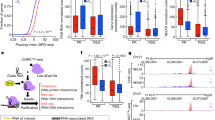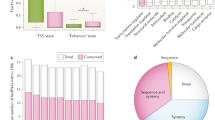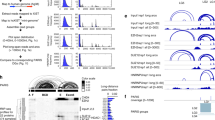Abstract
Transcriptome studies reveal many noncoding transcripts overlapping 3′ gene termini. The function of these transcripts is unknown. Here we have characterized transcription at the progesterone receptor (PR) locus and identified noncoding transcripts that overlap the 3′ end of the gene. Small RNAs complementary to sequences beyond the 3′ terminus of PR mRNA modulated expression of PR, recruited argonaute 2 to a 3′ noncoding transcript, altered occupancy of RNA polymerase II, induced chromatin changes at the PR promoter and affected responses to physiological stimuli. We found that the promoter and 3′ terminal regions of the PR locus are in close proximity, providing a potential mechanism for RNA-mediated control of transcription over long genomic distances. These results extend the potential for small RNAs to regulate transcription to target sequences beyond the 3′ termini of mRNA.
This is a preview of subscription content, access via your institution
Access options
Subscribe to this journal
Receive 12 print issues and online access
$259.00 per year
only $21.58 per issue
Buy this article
- Purchase on Springer Link
- Instant access to full article PDF
Prices may be subject to local taxes which are calculated during checkout







Similar content being viewed by others
Accession codes
References
Siomi, H. & Siomi, M.C. On the road to reading the RNA-interference code. Nature 457, 396–404 (2009).
Morris, K.V., Chan, S.W., Jacobsen, S.E. & Looney, D.J. Small interfering RNA-induced transcriptional gene silencing in human cells. Science 305, 1289–1292 (2004).
Ting, A.H., Schuebel, K.E., Herman, J.G. & Baylin, S.B. Short double-stranded RNA induces transcriptional gene silencing in human cancer cells in the absence of DNA methylation. Nat. Genet. 37, 906–910 (2005).
Janowski, B.A. et al. Inhibiting gene expression at transcription start sites in chromosomal DNA by antigene RNAs. Nat. Chem. Biol. 1, 216–222 (2005).
Li, L.C. et al. Small dsRNAs induce transcriptional activation in human cells. Proc. Natl. Acad. Sci. USA 103, 17337–17342 (2006).
Janowski, B.A. et al. Activating gene expression in mammalian cells with promoter-targeted duplex RNAs. Nat. Chem. Biol. 3, 166–173 (2007).
Liu, J. et al. Argonaute2 is the catalytic engine of mammalian RNAi. Science 305, 1437–1441 (2004).
Janowski, B.A. et al. Involvement of Ago1 and Ago2 link mammalian transcriptional silencing. Nat. Struct. Mol. Biol. 13, 787–792 (2006).
Kim, D.H., Villeneuve, L.M., Morris, K.V. & Rossi, J.J. Argonaute-1 directs siRNA-mediated transcriptional gene silencing in human cells. Nat. Struct. Mol. Biol. 13, 793–797 (2006).
Han, J., Kim, D. & Morris, K.V. Promoter-associated RNA is required for RNA-directed transcriptional gene silencing in human cells. Proc. Natl. Acad. Sci. 104, 12422–12427 (2007).
Schwartz, J.C. et al. Antisense transcripts are targets for activating small RNAs. Nat. Struct. Mol. Biol. 15, 842–848 (2008).
He, Y., Vogelstein, B., Velculescu, V.E., Papadopoulos, N. & Kinzler, K.W. The antisense transcriptomes of human cells. Science 322, 1855–1857 (2008).
Kapranov, P. et al. RNA maps reveal new RNA classes and a possible function for pervasive transcription. Science 316, 1484–1488 (2007).
Sun, M., Hurst, L.D., Carmichael, G.G. & Chen, J. Evidence for a preferential targeting of 3′-UTRs by cis-encoded natural antisense transcripts. Nucleic Acids Res. 33, 5533–5543 (2005).
Gingeras, T.R. Origin of phenotypes: genes and transcripts. Genome Res. 17, 682–690 (2007).
Wahlestedt, C. Natural antisense and noncoding RNA transcripts as potential drug targets. Drug Discov. Today 11, 503–508 (2006).
Amaral, P.P. & Mattick, J.S. Noncoding RNA in development. Mamm. Genome 19, 454–492 (2008).
Chen, J.-M., Ferec, C. & Cooper, D.N. A systematic analysis of disease-associated variants in the 3′ regulatory regions of human protein-coding genes II: the importance of mRNA secondary structure in assessing the functionality of 3′ UTR variants. Hum. Genet. 120, 301–333 (2006).
Kastner, P. et al. Two distinct estrogen-regulated promoters generate transcripts encoding the two functionally different human progesterone receptor forms A and B. EMBO J. 9, 1603–1614 (1990).
Birmingham, A. et al. 3′-UTR seed matches, but not overall identity, are associated with RNAi off-targets. Nat. Methods 3, 199–204 (2006).
Hornung, V. et al. Sequence-specific potent induction of IFN-α by short interfering RNA in plasmacytoid dendritic cells through TLR7. Nat. Med. 11, 263–270 (2005).
Barski, A. et al. High resolution profiling of histone methylations in the human genome. Cell 129, 823–837 (2007).
Keen, J.C. et al. Protein phosphatase 2A regulates estrogen receptor α (ER) expression through modulation of ER mRNA stability. J. Biol. Chem. 280, 29519–29524 (2005).
Nardulli, A.M., Greene, G.L., O'Malley, B.W. & Katzenellenbogen, B.S. Regulation of progesterone receptor messenger ribonucleic acid and protein levels in MCF-7 cells by estradiol: analysis of estrogen's effect on progesterone receptor synthesis and degradation. Endocrinology 122, 935–944 (1988).
Cho, H., Aronica, S.M. & Katzenellenbogen, B.S. Regulation of progesterone receptor gene expression in MCF-7 breast cancer cells: a comparison of the effects of cyclic adenosine 3′,5′-monophosphate, estradiol, insulin-like growth factor-1, and serum factors. Endocrinology 134, 658–664 (1994).
Stoica, A., Saceda, M., Doraiswamy, V.L., Coleman, C. & Martin, M.B. Regulation of estrogen receptor-α gene expression by epidermal growth factor. J. Endocrinol. 165, 371–378 (2000).
Zaragoza, D.B., Wilson, R.R., Mitchell, B.F. & Olson, D.M. The interleukin 1beta-induced expression of human prostaglandin F2α receptor messenger RNA in human myometrial-derived ULTR cells requires the transcription factor, NFkappaB. Biol. Reprod. 75, 697–704 (2006).
Gilbert, C., Kristjuhan, A., Winkler, G.S. & Svejstrup, J.Q. Elongator interactions with nascent mRNA revealed by RNA immunoprecipitation. Mol. Cell 14, 457–464 (2004).
Nelson, P.T. et al. A novel monoclonal antibody against human argonaute proteins reveals unexpected characteristics of miRNAs in human blood cells. RNA 13, 1787–1792 (2007).
O'Sullivan, J.M. et al. Gene loops juxtapose promoters and terminators in yeast. Nat. Genet. 36, 1014–1018 (2004).
Tan-Wong, S.M., French, J.D., Proudfoot, N.J. & Brown, M.A. Dynamic interactions between the promoter and terminator regions of the mammalian BRCA1 gene. Proc. Natl. Acad. Sci. USA 105, 5160–5165 (2008).
Tiwari, V.K. et al. PcG proteins, DNA methylation and gene repression by chromatin looping. PLoS Biol. 6, e306 (2008).
Smith, T.M. et al. Complete genomic sequence and analysis of 117 kb of human DNA containing the Gene BRCA1. Genome Res. 6, 1029–1049 (1996).
Miki, Y. et al. A strong candidate for the breast and ovarian cancer susceptibility gene BRCA1. Science 266, 66–71 (1994).
Ma, Y. et al. The breast cancer susceptibility gene BRCA1 regulates progesterone receptor signaling in mammary epithelial cells. Mol. Endocrinol. 20, 14–34 (2006).
Tsai, C.-L., Rowntree, R.K., Cohen, D.E. & Lee, J.T. Higher order chromatin structure at the X-inactivation center via looping DNA. Dev. Biol. 319, 416–425 (2008).
Colley, S.M. & Leedman, P.J. SRA and its binding partners: an expanding role for RNA-binding co-regulators in nuclear receptor-mediated gene regulation. Crit. Rev. Biochem. Mol. Biol. 44, 25–33 (2009).
Kuwabara, T., Hsieh, J., Nakashima, K., Taira, K. & Gage, F.H. A small modulatory dsRNA specifies the fate of adult neural stem cells. Cell 116, 779–793 (2004).
Cassiday, L.A. & Maher, L.J. Having it both ways: transcription factors that bind RNA and DNA. Nucleic Acids Res. 30, 4118–4126 (2002).
Kurokawa, R., Rosenfeld, M.G. & Glass, C.K. Transcriptional regulation through noncoding RNAs and epigenetic modifications. RNA Biol. 6, 233–236 (2009).
D'Orso, I. & Frankel, A.D. Tat acetylation modulates assembly of a viral host RNA-protein transcription complex. Proc. Natl. Acad. Sci. USA 106, 3101–3106 (2009).
Southgate, C., Zapp, M.L. & Green, M.R. Activation of transcription by HIV-1 Tat protein tethered to nascent RNA through another protein. Nature 345, 640–642 (1990).
Willy, P.J., Kobayashi, R. & Kadonaga, J.T. A basal transcription factor that activates or represses transcription. Science 290, 982–985 (2000).
Chahrour, M. et al. MeCP2, a key contributor to neurologic disease, activates and represses transcription. Science 320, 1224–1229 (2008).
Scsucova, S. et al. The repressor DREAM acts as a transcriptional activator on Vitamin D and retinoic acid response elements. Nucleic Acids Res. 33, 2269–2279 (2005).
Dubnicoff, T. et al. Conversion of Dorsal from an activator to a repressor by the global corepressor Groucho. Genes Dev. 11, 2952–2957 (1997).
Glass, C.K., Lipkin, S.M., Devary, O.V. & Rosenfeld, M.G. Positive and negative regulation of gene transcription by a retinoic acid-thyroid hormone receptor heterodimer. Cell 59, 697–708 (1989).
Hershberger, P.A. et al. Regulation of endogenous gene expression in human non-small cell lung cancer cells by estrogen receptor ligands. Cancer Res. 65, 1598–1605 (2005).
Goodrich, J.A. & Kugel, J.F. From bacteria to humans, chromatin to elongation, and activation to repression: the expanding roles of noncoding RNAs in regulating transcription. Crit. Rev. Biochem. Mol. Biol. 44, 3–15 (2009).
Acknowledgements
This work was supported by grants from the US National Institutes of Health (NIGMS GM77253 to D.R.C., GM85080 to B.A.J. and NIBIB EB 05556 to J.C.S.) and the Robert A. Welch Foundation (I-1244 to D.R.C.). B.A.J. was also supported by the High Impact/High Risk Grants Program, UT Southwestern Medical Center, and an Institutional Research Grant from the American Cancer Society (IRG-02-196-04). We gratefully acknowledge Z. Mourelatos (Univ. Pennsylvania) for providing anti-argonaute antibody. We thank A. Bhat for technical assistance and J. Watts for comments on the manuscript.
Author information
Authors and Affiliations
Contributions
All authors designed experiments and analyzed data. All authors except D.R.C. performed experiments. D.R.C. wrote the manuscript. The authors recognize that the contributions of J.C.S. and Y.C. would have been sufficient to merit separate publications.
Corresponding authors
Ethics declarations
Competing interests
The authors have licensed intellectual property related to this work to Alnylam Pharmaceutical.
Supplementary information
Supplementary Text and Figures
Supplementary Methods, Supplementary Results, Supplementary Tables 1–12 and Supplementary Figures 1–25 (PDF 16670 kb)
Rights and permissions
About this article
Cite this article
Yue, X., Schwartz, J., Chu, Y. et al. Transcriptional regulation by small RNAs at sequences downstream from 3′ gene termini. Nat Chem Biol 6, 621–629 (2010). https://doi.org/10.1038/nchembio.400
Received:
Accepted:
Published:
Issue Date:
DOI: https://doi.org/10.1038/nchembio.400
This article is cited by
-
Small RNAs, spermatogenesis, and male infertility: a decade of retrospect
Reproductive Biology and Endocrinology (2023)
-
RNA activation in ticks
Scientific Reports (2023)
-
The current state and future directions of RNAi-based therapeutics
Nature Reviews Drug Discovery (2019)
-
Nuclear functions of mammalian MicroRNAs in gene regulation, immunity and cancer
Molecular Cancer (2018)



